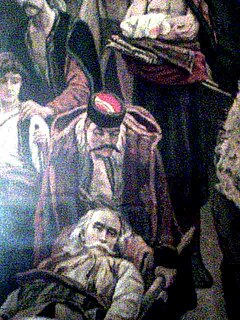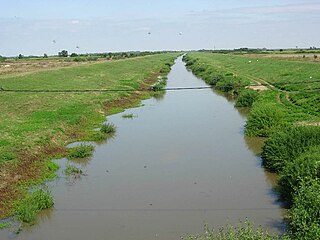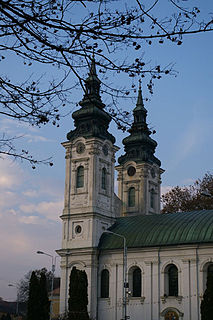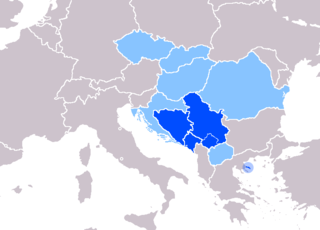
The Gorani[ɡɔ̌rani] or Goranci[ɡɔrǎːntsi]; are a Slavic Muslim ethnic group inhabiting the Gora region - the triangle between Kosovo, Albania, and North Macedonia. They number an estimated 60,000 people, and speak a transitional South Slavic dialect, called Goranski.
Crna Gora, meaning "black mountain" in Serbo-Croatian, is a place name found in former Yugoslavia. It may refer to:

The Montenegrin cap is a cap traditionally worn in Montenegro by the Montenegrins and Serbs of Montenegro.

The Karaš or Caraș is a 110-kilometre (68 mi) long river in the Banat region of Vojvodina, Serbia and Romania and a left tributary of the Danube.

The Eyalet of Temeşvar, known as Eyalet of Yanova after 1658, was a first-level administrative unit (eyalet) of the Ottoman Empire located in the Banat region of Central Europe.

Bela Crkva is a town and municipality located in the South Banat District of the autonomous province of Vojvodina, Serbia. The town has a population of 8,868, while the Bela Crkva municipality has 17,285 inhabitants.

The Nera is a 124-kilometre-long (77-mile) river running through Romania and Serbia. It is a left tributary of the Danube, which it joins near Banatska Palanka.

Gora is a geographical region in southern Kosovo, northeastern Albania, and northwestern North Macedonia inhabited by Albanians, Macedonians, Bosniaks, Bulgarians, Gorani, Serbs and Turks. Between 1992 and 1999, the part of Gora in Kosovo was a municipality, and its population was 17,574 people according to the 1991 census. Today, the region is part of the municipality of Dragaš in Kosovo. The Albanian part of Gora is included in the Shishtavec and Zapod municipalities, while the Macedonian portion is in the northeastern part of Bogovinje Municipality.

Pljevlja Municipality is one of the municipalities of Montenegro. The center is Pljevlja. It covers an area of 1,346 and had a population of 30,786 at the 2011 Census.

Crna Trava is a village and municipality located in the Jablanica District of southern Serbia. According to 2011 census, the population of the village is 434 inhabitants, while population of the municipality is 1,663. This is the smallest by population and poorest municipality in Serbia.

The Bârzava or Brzava is a river in Romania and Serbia. The Bârzava is 166 km long, has a drainage area of 1,190 km² and flows into the river Timiș.
The Serbs of Romania are a recognized ethnic minority numbering 18,076 people (0.1%) according to the 2011 census. The community is concentrated in western Romania, in the Romanian part of the Banat region, where they constitute absolute majority in two communes and relative majority in one other.

Banatska Palanka is a village in Serbia. It is situated in the Bela Crkva municipality, South Banat District, Vojvodina province. The population of the village is 837, of whom 752 (89.84%) are ethnic Serbs.

Koza nostra is the tenth studio album from Serbian and former Yugoslav rock band Riblja Čorba, released in 1990.

Skopska Crna Gora, often called and only as Crna Gora, also historically known as Karadağ, is a mountain range largely in North Macedonia, with smaller part in Kosovo. It lies between the cities of Kaçanik and Skopje. The highest peak is Ramno in North Macedonia. The largest town on the mountain is Kučevište in North Macedonia.

The Serbian Progressive Party in Macedonia (SNSM) is a political party in the Republic of Macedonia.
Jovan Tomić was Serbian historian and member of Serbian Academy of Science and Arts. He was the director of the National Library of Serbia, from 1903 to 1927.

Kosovo Pomoravlje or Anamorava, is a valley in Kosovo, in the southern part of the District of Gjilan surrounding the Binač Morava River. It stretches eastward to the Preševo Valley in southern Serbia. The mountains in this region, rising to an altitude of 1,000–1,200 metres (3,300–3,900 ft), border the Skopska Crna Gora region in neighboring Macedonia north of Skopje. Gjilan, Kosovska Kamenica, Novo Brdo and Vitina are municipalities located in the region. The region gave its name to Kosovo Pomoravlje District. It is known for recording the lowest temperature in Kosovo: −32.5 °C (−26.5 °F), on 25 January 1963.
Užička Crna Gora is a mountainous region in western Serbia around the town of Užice. To the east lies Šumadija; Užička Crna Gora borders to the region of Rudnik, which lies in Šumadija, however, the border between the two is unclear due to historical administrative changes.
Ivan Lukačević, known as Podgoričanin (Подгоричанин), was a Russian Imperial captain of Serb origin from Podgorica that participated in planning of a Balkan Orthodox uprising with Russian aid against the Ottoman Empire. He was sent with Russian colonel of Serb origin, Mikhail Miloradovich ,to deliver documents issued by emperor Peter the Great on 3 March 1711 that called the Balkan Orthodox to rise up against the Ottomans during the Pruth River Campaign. Miloradović and Lukačević arrived at Cetinje and delivered them to metropolitan Danilo, who had them read at a Montenegrin church assembly. This was the first Russian delegation to Montenegro. Danilo, Miloradović and Lukačević then organized military operations. In September 1712, Lukačević left Montenegro and headed for Russia. However, he was left in Berlin.


















